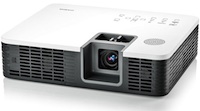Casio Launches Hybrid Light Source Projectors

The 3,500-lumen XJ-H1600 is part of Casio's upcoming "hybrid" line of projectors using both lasers and LED in place of conventional lamps. |
Casio has debuted a new lineup of projectors that work with a combination of lasers and LEDs instead of lamps. The light sources produce up to 3,500 lumens of brightness and have an estimated life of 20,000 hours.
Casio introduced 12 of the new "hybrid" projectors this week, including two new hybrid models in Casio's short-throw line.
All of the new projectors--scheduled to ship later this year--use 3D-ready DLP display technology and include an interactive whiteboard feature, support for MobiShow, and an economy mode that automatically adjusts brightness to adapt to a room's ambient lighting conditions.
Short Throw Projectors
The short-throw XJ-ST145 offers a resolution of 1,024 x 768 (XGA), a contrast ratio of 1,800:1, and a brightness of 2,500 lumens. The other new short-throw model, the XJ-ST155, also features an XGA resolution and an 1,800:1 contrast ratio but offers a brightness of 3,000 lumens. Both come equipped with a short-throw lens that can project a 60-inch (diagonal) image from 2.64 feet.
Both of the new models also include:
- 802.11b/g wireless networking capabilities;
- 10Base-T/100Base-TX wired network connectivity;
- USB (A and B) and RS-232;
- ±30 degree auto and manual keystone correction;
- Security features that include power-on password and Kensington lock compatibility; and
- 10 watt mono speaker.
AV ports include HDMI; component/RGB (mini D-Sub 15-pin); S-video; composite video; stereo audio in (both 3.5 mm minijack and stereo RCA jacks); and stereo minijack out.
High-Brightness Projectors
Two of the new hybrid models offer a brightness of 3,500 lumens. The XJ-H1650 and XJ-H1600 also feature an XGA resolution and a 1,400:1 contrast ratio. The H1650 is a network model featuring 802.11b/g wireless networking capabilities and 10Base-T/100Base-TX wired network connectivity. Both also offer:
- 1.2x optical zoom;
- USB (A and B) and RS-232;
- ±30 degree auto and manual keystone correction;
- Power-on password and Kensington lock compatibility; and
- 10 watt mono speaker.
As with the short-throw models, the H-series hybrid projectors' AV ports include HDMI; component/RGB (mini D-Sub 15-pin); S-video; composite video; stereo audio in (both 3.5 mm minijack and stereo RCA jacks); and stereo minijack out.
Low-Wattage Projectors
Casio has also introduced eight models that consume less than half the power of the H- and ST-series projectors. The M-series, which includes four networkable projectors, use 150 watts in economy mode and 190 watts in bright mode. (That compares with 350 watts in economy mode for the H- and ST-series and 430 watts in bright mode.)
Four of the models offer XGA resolution. Of those, the XJ-M155 and XJ-M150 offer a brightness of 3,000 lumens, while the XJ-M145, and XJ-M140 offer a brightness of 2,500 lumens. There are also four WXGA models (1,280 x 800 resolution) in the M-series. The XJ-M255 and XJ-M250 sport a 3,000-lumen brightness; the XJ-M245 and XJ-M240 offer a brightness of 2,500 lumens. All eight models feature a contrast ratio of 1,800:1. All weigh in at 8.6 pounds.
The XJ-M155, XJ-M145, XJ-M255, and XJ-M245 include built-in 802.11b/g wireless networking capabilities and 10/100 wired connectivity.
Other features common to the M-series projectors include:
- 1.5x optical zoom;
- USB (A and B) and RS-232;
- ±30 degree auto and manual keystone correction;
- Power-on password and Kensington lock compatibility; and
- 5 watt mono speaker.
AV ports include HDMI; component/RGB (mini D-Sub 15-pin); S-video; composite video; stereo audio in (both 3.5 mm minijack and stereo RCA jacks); and stereo minijack out.
Pricing for the hybrid laser/LED models hasn't been released yet. The models are expected to start shipping this summer. Further details can be found here.